Get all StockDreams.ai Bundle Deal: All The links to the direct sales pages. With the big StockDreams ai OTO discount and three hot Bonuses packages. see all the StockDreams ai OTO sales pages below, with all info for each OTOs
StockDreams.ai OTO Links + Three Hot Bonuses Below
>> Front-End <<
>> OTO1 Pro Edition <<
>> OTO2 Banner Generator Edition <<
>> OTO3 Agency Edition <<
StockDreams ai OTO ” All OTOs Links Above
StockDreams ai OTO – Understanding Personalized Curriculum Design
What is personalized curriculum design?
Personalized curriculum design involves creating learning experiences that are tailored to meet the specific needs, interests, and learning styles of each individual student. Rather than using a one-size-fits-all approach, personalized curriculum design takes into account the unique strengths, weaknesses, and preferences of each student, allowing them to learn at their own pace and in a way that is most effective for them. This approach recognizes that every student is different and requires personalized attention to maximize their learning potential.
Importance of personalized curriculum
Personalized curriculum is essential for promoting student engagement, motivation, and ownership of the learning process. By catering to the unique needs and learning styles of individual students, personalized curriculum design can help students develop a deeper understanding of the subject matter, retain information for longer periods, and apply their knowledge in real-world situations. It also fosters a sense of autonomy and self-efficacy, as students feel empowered to take charge of their own learning journey. Ultimately, personalized curriculum design can lead to improved academic outcomes and a love for lifelong learning.
Challenges in designing personalized curriculum
While the benefits of personalized curriculum are evident, there are several challenges that educators and designers face when implementing this approach. One major challenge is the enormity of the task; designing personalized curriculum for each individual student requires significant time and effort. Additionally, the availability of resources, such as technology and materials, can pose a challenge, especially in contexts where resources are limited. Furthermore, ensuring that the personalized curriculum aligns with educational standards and objectives can be demanding. Despite these challenges, advancements in artificial intelligence (AI) offer promising solutions to overcome these obstacles and make personalized curriculum design more feasible and effective.
StockDreams ai OTO – Role of AI in Personalized Curriculum Design
Introduction to AI in education
AI refers to the simulation of human intelligence in machines that are programmed to think and learn like humans. In the field of education, AI has the potential to revolutionize the way curricula are designed and delivered. It can analyze vast amounts of student data, provide personalized feedback, adapt to individual learning needs, and offer tailored learning experiences. From virtual tutors to adaptive learning systems, AI tools are designed to enhance the learning process and cater to the unique needs of each student.
Benefits of AI in curriculum design
The integration of AI in curriculum design brings numerous benefits. Firstly, AI can automate the collection and analysis of student data, making it easier for educators to gain insight into each student’s strengths, weaknesses, and progress. This data-driven approach allows for more informed decision-making and the ability to fine-tune curriculum content to better suit individual needs. Secondly, AI can provide personalized feedback and guidance, allowing students to receive immediate and targeted support. This helps to bridge gaps in understanding and ensures that students receive the necessary assistance when and where they need it. Lastly, AI can adapt to individual learning styles and preferences, offering customized learning pathways and content recommendations. This promotes engagement, motivation, and a sense of ownership over the learning process.
AI techniques for personalized curriculum design
AI utilizes various techniques to facilitate personalized curriculum design. One such technique is supervised learning, where algorithms are trained using labeled data to predict outcomes or make decisions. In the context of curriculum design, supervised learning can be used to identify patterns and predict students’ performance, allowing for the creation of tailored content and interventions. Unsupervised learning, on the other hand, involves analyzing unlabeled data to generate insights and identify hidden patterns. This can be useful for identifying common misconceptions or gaps in understanding that can be addressed in the curriculum design. Finally, reinforcement learning involves creating an environment where AI algorithms can learn through trial and error. This technique can be employed to provide tailored learning experiences that adapt and adjust based on students’ responses and progress.
Data Collection and Analysis
Collecting student data
To create personalized curricula, it is essential to collect relevant and meaningful data about each student. This can include a variety of information such as demographic data, academic performance, learning preferences, and interests. Data collection can occur through various methods, such as assessments, surveys, observations, and even through the use of AI-powered tools. It is important to ensure that data collection processes prioritize student privacy and adhere to ethical guidelines.
Analyzing student data
Once the data has been collected, it needs to be carefully analyzed to extract meaningful insights. AI tools can play a crucial role in analyzing large amounts of data to identify patterns, trends, and correlations. This analysis can help educators understand each student’s strengths, weaknesses, learning styles, and preferences. By identifying these factors, educators can tailor the curriculum content, teaching methods, and interventions to optimize learning outcomes for each student.
Understanding learning preferences and needs
Through the analysis of student data, educators can gain a deeper understanding of individual learning preferences and needs. Some students may thrive in collaborative learning environments, while others may prefer independent learning. Some students may require additional support in certain areas, while others may need opportunities for extension and enrichment. By understanding these preferences and needs, educators can design personalized curriculum that takes into account the unique characteristics of each student, fostering a more effective and engaging learning experience.
StockDreams ai OTO – Machine Learning Algorithms
Supervised learning for curriculum design
Supervised learning algorithms can play a significant role in curriculum design by predicting students’ performance and identifying areas for improvement. By training algorithms on labeled data, such as past student performance or expert annotations, the algorithms can learn to make predictions or decisions about future student outcomes. This information can then be used to adapt the curriculum design, providing tailored content and interventions to address specific learning needs and challenges.
Unsupervised learning for curriculum design
Unsupervised learning algorithms can analyze large amounts of unlabeled data to identify patterns and hidden structures. In the context of curriculum design, unsupervised learning can help identify common misconceptions, areas of confusion, or gaps in understanding among students. These insights can then be used to design curriculum content that directly addresses these issues and supports students in overcoming their challenges.
Reinforcement learning for tailored learning experiences
Reinforcement learning involves creating an environment where AI algorithms can learn through trial and error, receiving feedback based on their actions. In the context of personalized curriculum design, reinforcement learning can be used to create tailored learning experiences that adapt and adjust based on students’ responses and progress. By providing immediate and targeted feedback, reinforcement learning algorithms can guide students towards mastery and provide scaffolding when needed, ultimately enhancing the effectiveness of the learning process.
Adaptive Learning Systems
Overview of adaptive learning systems
Adaptive learning systems are AI-powered tools that dynamically adjust and personalize the learning experience based on individual students’ needs and performance. These systems utilize algorithms and data analysis techniques to continually assess students’ progress and adapt the curriculum content and delivery accordingly. Adaptive learning systems offer a more flexible and responsive approach to education, allowing students to receive customized support and move through the curriculum at their own pace.
Personalized learning pathways
One key feature of adaptive learning systems is the creation of personalized learning pathways. These pathways are designed to meet the individual needs and goals of each student, taking into account their learning styles, prior knowledge, and performance data. Based on ongoing assessments and analysis of student progress, the adaptive learning system can suggest and optimize the sequence of learning activities, ensuring that each student receives the right content at the right time.
Individualized content recommendations
Adaptive learning systems can also provide individualized content recommendations to students, based on their performance and learning preferences. These recommendations can include supplementary materials, additional practice exercises, or enrichment activities to deepen understanding and support specific areas of growth. By tailoring the content to each student’s needs, adaptive learning systems foster engagement, motivation, and a sense of relevance in the learning process.
Natural Language Processing
Understanding student responses
Natural Language Processing (NLP) is a branch of AI that focuses on the interaction between computers and human language. In the context of personalized curriculum design, NLP can be utilized to understand students’ responses to questions or prompts. By analyzing the text or speech input, NLP algorithms can extract meaning, identify misconceptions, and provide targeted feedback. This allows for personalized support and guidance, even in large-scale educational settings.
Automated feedback and grading
NLP can also automate the feedback and grading process, providing timely and targeted feedback to students. By analyzing the quality and content of students’ responses, NLP algorithms can provide personalized feedback, highlighting areas of strength and areas for improvement. This automated feedback can save educators time and effort, allowing them to focus on providing more targeted interventions and support.
Enhancing communication and collaboration
In addition to understanding and analyzing student responses, NLP can enhance communication and collaboration in personalized curriculum design. NLP algorithms can facilitate real-time interactions between students and virtual tutors or peers, providing instant feedback and promoting discussions. This fosters collaboration and engagement among students, creating a supportive and interactive learning environment.
Intelligent Tutoring Systems – Stock Dreams ai OTOs
Virtual tutors for personalized guidance
Intelligent Tutoring Systems (ITS) are AI-powered tools that provide personalized guidance and support to students. These virtual tutors can adapt to individual learning styles and preferences, offering tailored explanations, practice exercises, and feedback. ITS can analyze student performance data and dynamically adjust the curriculum content and delivery to maximize learning outcomes. By providing personalized guidance, ITS empower students to take charge of their learning journey and foster a deeper understanding of the subject matter.
Real-time performance monitoring
Intelligent Tutoring Systems continuously monitor student performance in real-time, allowing educators to gain immediate insights into each student’s progress. By analyzing students’ responses, ITS can identify misconceptions, areas of difficulty, or strengths and provide targeted interventions accordingly. This real-time performance monitoring not only allows for customized support but also enables educators to assess the effectiveness of the curriculum design and make informed adjustments when necessary.
Scaffolding and support for mastery learning
Intelligent Tutoring Systems can provide scaffolding and support for mastery learning. By offering hints, step-by-step guidance, and additional practice opportunities, ITS help students gradually build their knowledge and skills, moving towards mastery. This personalized support ensures that students receive the assistance they need, promoting a deeper understanding of the content and facilitating the development of independent problem-solving skills.
Gamification and Personalization
Utilizing game elements for engagement
Gamification involves incorporating game elements, such as competition, rewards, and challenges, into non-game contexts to increase engagement and motivation. In personalized curriculum design, gamification techniques can be used to make learning more enjoyable and interactive. By incorporating game elements, such as leaderboards, badges, and levels, into the curriculum, students are incentivized to actively participate and progress through the content. This creates a sense of excitement and enthusiasm, enhancing the overall learning experience.
Tailoring game experiences to individual students
AI can personalize game experiences by adapting the game content and difficulty level to the individual student’s needs and abilities. By analyzing student performance data, AI algorithms can determine the appropriate level of challenge for each student, ensuring that they are neither overwhelmed nor bored. This personalized approach maximizes engagement and motivation, as students feel a sense of achievement and progress at their own pace.
Motivating and rewarding personalized achievements
AI-powered tools can recognize and reward personalized achievements, providing students with a sense of accomplishment and motivation. By tracking progress, AI algorithms can award badges, certificates, or virtual rewards based on individual achievements. These rewards not only serve as reinforcement for the learning process but also foster a sense of pride and ownership in the students’ accomplishments.
Ethical Considerations
Privacy and security of student data
As AI tools gather and analyze student data for personalized curriculum design, it is crucial to prioritize the privacy and security of that data. Educators and designers must ensure that appropriate measures are in place to protect student data from unauthorized access, breaches, or misuse. Transparency and clear consent processes should be established to inform students and their families about data collection and usage, while also offering options for data anonymization and deletion.
Bias in AI-powered curriculum design
Another ethical consideration in AI-powered curriculum design is the potential for bias. AI algorithms are only as good as the data they are trained on, and if that data contains biased or disproportionate information, it can lead to biased outcomes. It is essential to regularly evaluate and audit the algorithms and data sources to identify and address any biases that may emerge. Curriculum designers must actively work towards creating inclusive and equitable learning experiences that do not perpetuate biases or discriminatory practices.
Ensuring inclusivity and fairness
AI-powered personalized curriculum design should strive for inclusivity and fairness by ensuring that all students have equitable access to resources, opportunities, and support. Designers should carefully consider the diverse needs and backgrounds of students and ensure that the curriculum addresses their unique circumstances. Additionally, AI algorithms should be designed to recognize and adapt to different learning styles, preferences, and abilities, promoting an inclusive learning environment for all students.
Implementing AI Tools in Education
Training educators to use AI tools
To effectively implement AI tools in personalized curriculum design, educators need proper training and support. Educators should be equipped with the necessary skills to understand, utilize, and adapt AI tools to meet the needs of their students. Training programs should focus on familiarizing educators with the capabilities and limitations of AI, as well as providing guidance on data collection, analysis, and interpretation. By empowering educators with AI literacy, they can effectively leverage AI tools to enhance the personalized learning experience for their students.
Integration with existing curriculum frameworks
When implementing AI tools in personalized curriculum design, it is essential to integrate them seamlessly with existing curriculum frameworks. AI should complement and enrich the curriculum rather than replace or disrupt existing educational practices. By aligning AI-powered tools with educational standards and objectives, educators can ensure that the personalized curriculum meets the desired learning outcomes while leveraging the benefits of AI to enhance the learning experience.
Evaluating the effectiveness of AI in personalized learning
To measure the effectiveness of AI in personalized learning, rigorous evaluation and assessment methods should be employed. Educators should establish appropriate metrics and assessment frameworks to assess student outcomes and measure the impact of personalized curriculum design. Regular evaluation and feedback from both educators and students can provide valuable insights into the effectiveness of AI tools and inform continuous improvement efforts. By gathering evidence of the impact and benefits of AI in personalized learning, educators can make informed decisions regarding the optimization and refinement of the curriculum design.
In conclusion, AI tools have the potential to transform personalized curriculum design by analyzing student data, providing tailored guidance, and enhancing the learning experience. By utilizing techniques such as data analysis, machine learning algorithms, adaptive learning systems, natural language processing, intelligent tutoring systems, gamification, and considering ethical considerations, educators can design and implement personalized curricula that cater to the unique needs and learning preferences of each student. Through the integration of AI in education, personalized learning becomes more accessible, engaging, and effective, paving the way for a future where education is truly customized to meet the needs of every learner.
Your Free Hot Bonuses Packages
>> Hot Bonuses Package #1 <<
>> Hot Bonuses Package #2 <<
>> Hot Bonuses Package #3 <<
Table of Contents







